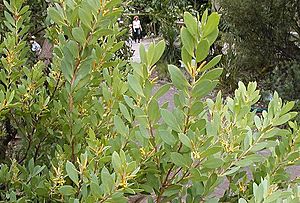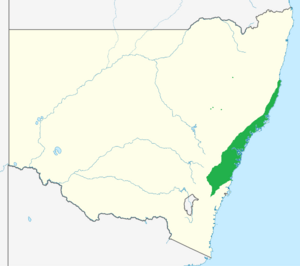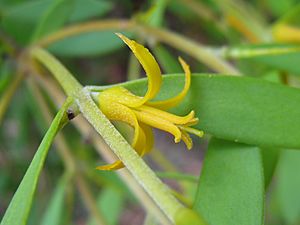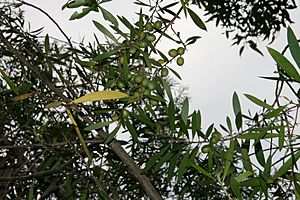Lance-leaf geebung facts for kids
Quick facts for kids Lance-leaf geebung |
|
|---|---|
 |
|
| Scientific classification | |
| Genus: |
Persoonia
|
| Species: |
lanceolata
|
 |
|
| Range of P. lanceolata in New South Wales | |
| Synonyms | |
|
Persoonia latifolia Andrews |
|
The Lance-leaf geebung (scientific name: Persoonia lanceolata) is a type of shrub that grows naturally in New South Wales, Australia. It can grow up to 3 meters (about 10 feet) tall. This plant has smooth grey bark and bright green leaves.
Its small yellow flowers bloom in the Australian summer and autumn, usually from January to April. After the flowers, it grows green, fleshy fruits called drupes. These fruits ripen the next spring, from September to October. The Lance-leaf geebung is part of a larger group of 58 similar Persoonia species. It can even mix with other species in its area.
You'll often find this plant in dry sclerophyll forests. It prefers sandy soils that don't have many nutrients. The Lance-leaf geebung is well-suited to areas where bushfires happen. If a fire destroys the plants, new ones can grow from seeds hidden in the soil. Most new plants sprout within two years after a fire.
Native bees, especially from the Leioproctus group, help pollinate its flowers. Swamp wallabies love to eat its fruits. They help spread the seeds when they leave their droppings. This plant can live for 25 to 60 years. However, it's hard to grow new plants from seeds or cuttings, so you don't often see it in gardens.
Contents
Naming and Discovery
The Lance-leaf geebung was first officially described in 1799 by a person named Henry Cranke Andrews. He grew the plant from seeds in England. The scientific name lanceolata comes from a Latin word meaning "spear-shaped." This refers to the shape of its leaves.
The common name "geebung" comes from the Dharug language, spoken by Aboriginal people in the Sydney area. For a while, some botanists tried to give it other names, but Andrews' original name, Persoonia lanceolata, was eventually chosen as the correct one.
In 1995, a botanist named Peter Weston studied the Persoonia group. He named a group of 58 closely related species the "lanceolata group" because they have similar flowers. These species often interbreed, meaning they can create mixed plants if they grow near each other. For example, P. lanceolata has been known to mix with P. levis and P. linearis. Like most plants in its group, P. lanceolata has seven chromosomes, which are quite large for a plant in the Proteaceae family.
What it Looks Like
The Lance-leaf geebung is a shrub that can grow from 0.5 to 3 meters (about 1.6 to 10 feet) tall. It has smooth grey bark, and its new shoots are a bit hairy.
Its leaves are thick and leathery. They are shaped like a spear or an oval, measuring about 3 to 10 cm (1.2 to 4 inches) long and 0.4 to 3.2 cm (0.16 to 1.3 inches) wide. When they are young, the leaves are hairy, but they become smooth as they grow. They are bright green, sometimes with a yellowish tint, and both sides of the leaf are the same color.
The yellow flowers usually appear from January to April, but you might see them at other times too. They grow in clusters along the stems, with each stem holding 4 to 54 flowers. Each flower sits on a short stalk, about 0.5 cm (0.2 inches) long, and can be up to 1 cm (0.4 inches) across.
Each flower has both male and female parts. It has a tube-like outer layer that splits into four sections. Inside, the male parts (anthers) surround the central female part (style). The anthers curl back, looking like a cross from above. This shape helps insects land and pick up pollen.
The fruits are green and round, about 1 cm (0.4 inches) long and 0.8 cm (0.3 inches) wide. They contain two seeds and weigh about 1.3 grams (0.05 ounces). As they ripen, they turn partly red and fall to the ground in spring (September to October). Once on the ground, they soften and turn dark red before shriveling up and turning black. Local Aboriginal people used to eat these fruits.
You can tell P. lanceolata apart from a similar plant, P. levis, by its firm bark and spear-shaped leaves. P. levis has flaky bark and leaves that are not symmetrical.
Where it Grows and Lives
The Lance-leaf geebung is found along the coast and nearby areas of New South Wales, Australia. It grows from Trial Bay in the north down to Sassafras in the south.
It likes dry sclerophyll forests and heathlands, especially on sandy soils that don't have many nutrients. You'll often find it on the tops of ridges and slopes. Plants in more sheltered spots tend to be taller than those in exposed areas. This plant grows from sea level up to 700 meters (about 2,300 feet) high. The areas where it lives in the Sydney Basin usually get 900 to 1400 mm (35 to 55 inches) of rain each year.
The Lance-leaf geebung is well-protected in the Sydney region. You can find it in several national parks, including Bouddi, Brisbane Water, and Ku-ring-gai Chase National Parks.
In heathlands, it grows alongside plants like Banksia ericifolia and Darwinia fascicularis. In more forested areas, it grows as a smaller shrub under trees like Eucalyptus piperita and Corymbia gummifera.
Life Cycle and Ecology
The swamp wallaby (Wallabia bicolor) loves to eat the fallen fruits of the Lance-leaf geebung. When they eat the fruits, they help spread the seeds through their droppings. Foxes have also been seen eating the fruit, and it's thought that kangaroos and large birds like currawongs might eat them too.
Certain types of native bees, especially from the Leioproctus genus, visit and pollinate Persoonia flowers. These bees are very important because they only feed on Persoonia flowers. The European honey bee (Apis mellifera) also visits the flowers often. However, honeybees tend to visit many flowers on the same plant, while native bees are better at moving pollen between different plants. This means honeybees might not be as good at pollinating Persoonia lanceolata, which needs pollen from other plants to make seeds.
If a bushfire destroys P. lanceolata shrubs, new plants can grow from seeds that survived in the soil. A study in Ku-ring-gai Chase National Park found that new plants sprouted within two years after a 1994 bushfire. Some even appeared up to six years later. It takes about six years for these new plants to grow up and be able to reproduce. This means that if bushfires happen too often, it can be hard for new plants to grow and survive, which could put populations at risk. However, in some areas, plants matured faster after very intense fires. Scientists are still not sure what exactly makes the seeds sprout. The natural lifespan of a Lance-leaf geebung plant is usually between 25 and 60 years.
Growing and Uses
The Lance-leaf geebung is not often grown in gardens. This is mainly because it's hard to get its seeds to sprout, and cuttings don't easily grow roots. However, its bright green leaves are considered very attractive for gardens.
If you want to grow this plant, it needs sandy soil that drains well, and it prefers sun or partial shade. Once it's established, it can handle moderate frosts and dry periods. It grows quite well if the conditions are right. People in England were able to grow it from seeds as early as 1791.
Indigenous people on the Beecroft Peninsula used to eat the fruits of the Lance-leaf geebung. They even preferred them over the fruits of another similar plant, P. laurina.



